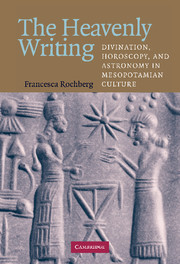Book contents
- Frontmatter
- Contents
- Preface
- Acknowledgments
- Abbreviations
- Chronological References and Akkadian and Astronomical Terminology
- The Heavenly Writing
- Prologue
- 1 The Historiography of Mesopotamian Science
- 2 Celestial Divination in Context
- 3 Personal Celestial Divination: The Babylonian Horoscopes
- 4 Sources for Horoscopes in Astronomical Texts
- 5 Sources for Horoscopes in the Early Astrological Tradition
- 6 The Scribes and Scholars of Mesopotamian Celestial Science
- 7 The Classification of Mesopotamian Celestial Inquiry as Science
- Epilogue
- Bibliography
- Name Index
- Subject Index
4 - Sources for Horoscopes in Astronomical Texts
Published online by Cambridge University Press: 08 January 2010
- Frontmatter
- Contents
- Preface
- Acknowledgments
- Abbreviations
- Chronological References and Akkadian and Astronomical Terminology
- The Heavenly Writing
- Prologue
- 1 The Historiography of Mesopotamian Science
- 2 Celestial Divination in Context
- 3 Personal Celestial Divination: The Babylonian Horoscopes
- 4 Sources for Horoscopes in Astronomical Texts
- 5 Sources for Horoscopes in the Early Astrological Tradition
- 6 The Scribes and Scholars of Mesopotamian Celestial Science
- 7 The Classification of Mesopotamian Celestial Inquiry as Science
- Epilogue
- Bibliography
- Name Index
- Subject Index
Summary
By the late fifth century b.c., judging by the appearance of horoscopes whose purpose was to determine aspects of an individual's life from celestial signs, the heavens were thought to bear meaning not only for the king and the state as in the traditional body of omen texts, but also for the individual. Not many of the extant horoscope texts contain statements concerning the life of the native, but all are introduced by the date of a birth. The intent is thereby unequivocal. Cuneiform horoscopy of necessity relied on the availability of recorded planetary and lunar data, rather than on observation, because not every planet is necessarily above the horizon at the moment of birth, nor obviously does every birth occur at night. This chapter aims to show the dependence of the Babylonian horoscopes on a variety of predictive and observational astronomical texts. From this it appears that the scribes who drew up horoscopes, although competent in all the aspects and methods of celestial science, or so we must assume, did not compute planetary positions for horoscopes directly, but utilized a wide range of astronomical texts at their disposal as reference material.
The development of the astronomical methods on which horoscopy depended can be traced back centuries before their culminating phase in the mid-first millennium, if one includes the evidence of early work on periodicities in the form of visibility and invisibility periods attested in texts such as mul.apin, Enūma Anu Enlil, or the astrological reports of the Neo-Assyrian period.
- Type
- Chapter
- Information
- The Heavenly WritingDivination, Horoscopy, and Astronomy in Mesopotamian Culture, pp. 121 - 163Publisher: Cambridge University PressPrint publication year: 2004



